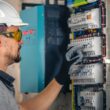Welcome to our comprehensive article on the intriguing topic of the Ag CuSO4 reaction. In this article, we will delve deep into the details of the reaction between silver (Ag) and copper sulfate (CuSO4), exploring its properties, applications, and underlying mechanisms. Whether you’re a chemistry enthusiast, a student, or simply curious about chemical reactions, join us as we uncover the secrets of this fascinating reaction.
What is the Ag CuSO4 Reaction?
The Ag CuSO4 reaction, also known as the silver copper sulfate reaction, is a captivating chemical process that involves the interaction between silver metal and copper sulfate solution. When these two substances are brought together, a unique reaction occurs, leading to the formation of visually striking and scientifically significant outcomes.
Key Components of the Reaction
The reaction comprises two main components:
- Silver (Ag): A lustrous, white metal known for its excellent electrical conductivity and distinctive appearance.
- Copper Sulfate (CuSO4): A blue crystalline compound that contains copper, sulfur, and oxygen. It is commonly used in various industrial and educational applications.
Reaction Mechanism
The Ag CuSO4 reaction involves a displacement reaction, also referred to as a single replacement reaction. During this process, the more reactive metal (silver) displaces the less reactive metal (copper) from its compound (copper sulfate). The reaction can be represented by the following chemical equation:
Ag + CuSO4 → AgSO4 + Cu
As a result of this reaction, silver sulfate (AgSO4) and copper metal (Cu) are formed. The silver sulfate is often observed as a white precipitate, while the displaced copper appears as a reddish-brown solid.
Applications and Significance
The Ag CuSO4 reaction holds both educational and practical significance:
- Education: This reaction is commonly used as a teaching tool in chemistry classrooms to demonstrate concepts such as single displacement reactions, reactivity series, and the principles of redox reactions.
- Art: The visually appealing color changes and the formation of distinct precipitates make this reaction a favorite among artists and crafters seeking unique patinas and finishes for their creations.
- Research: The Ag CuSO4 reaction has also found its place in scientific research, contributing to studies in fields such as material science and electrochemistry.
Frequently Asked Questions (FAQs)
Q: What is the purpose of the Ag CuSO4 reaction in educational settings?
A: In educational settings, this reaction serves as a hands-on illustration of chemical concepts, allowing students to witness the principles of displacement reactions and reactivity series in action.
Q: Can the Ag CuSO4 reaction be used for artistic purposes?
A: Absolutely! The reaction’s distinct color changes and precipitate formation make it a sought-after technique for artists aiming to achieve unique and appealing patinas on their artworks.
Q: How does the Ag CuSO4 reaction contribute to scientific research?
A: This reaction is valuable in scientific research, particularly in material science and electrochemistry, where its outcomes and mechanisms can provide insights into various processes and applications.
In Conclusion
The Ag CuSO4 reaction is an engrossing example of the fascinating world of chemistry. Its intricate mechanisms and visually captivating results make it a topic of interest for both educational and practical purposes. By understanding the Ag CuSO4 reaction, we gain insights into the fundamental principles that govern chemical interactions and their real-world applications.




